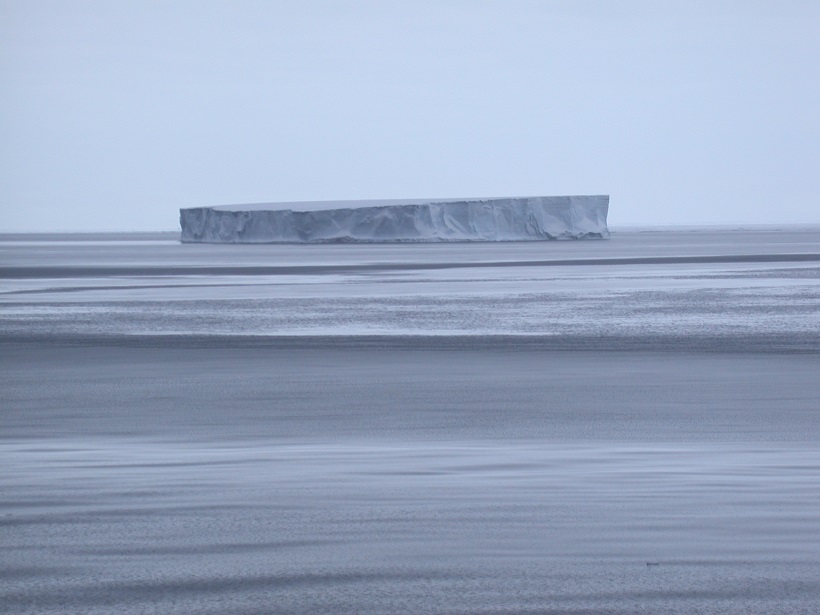The Weddell Gyre, delimited by a clockwise-rotating ocean flow in the Southern Ocean, covers an area more than half the size of the USA. Its characteristics control the physical and chemical properties of large parts of the global deep ocean, and it has the capability of influencing global climate on multiple timescales. A recent article in Reviews of Geophysics examines what is currently known about the Weddell Gyre and identifies where further research is needed. Here, the lead authors of the paper answer several questions about the challenges of studying the Weddell Gyre, different methods that have been used in research, and what they have revealed.
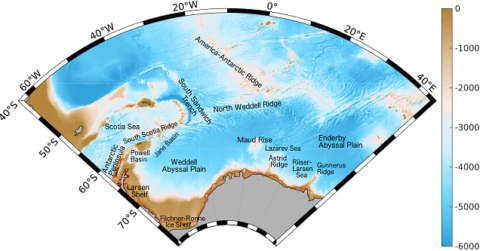
What are the main challenges of studying the Weddell Gyre?

This area of the Southern Ocean is an extremely cold, windy, seasonally variable and remote region. Sea ice and icebergs can preclude safe navigation, even for icebreakers and even in summer.
In fact, this was where Ernest Shackleton’s ship Endurance froze within sea ice in the austral summer of 1915 during their expedition to the South Pole.
Few research expeditions ventured that far south for many decades afterwards. There were just occasional visits, such as the U.S. GEOSECS (Geochemical Ocean Sections Study) oceanographic program which cruised into the region during the 1970s, until scientists from Alfred Wegener Institute in Germany started more consistent sampling from the mid-1980s.
However, sea ice conditions can vary significantly from year to year making it impossible to predict access several years in advance, which is the usual time frame for preparing a research expedition.
Also, cruises to such a remote location are very expensive. Thus, advances in our understanding of the Weddell Gyre system have been closely tied to accessibility, and its southern reaches have still never been studied in the winter.
What did this early research in the region reveal?
We started to understand more about the meteorology and oceanography of the Weddell Gyre from the 1980s, thanks to a combination of field observations and modelling efforts extending from the stratosphere to the deep ocean [Hellmer et al. 2016].
This included the influence of the Antarctic ozone hole on local atmospheric circulation and sea ice formation; solar irradiance and the role of sea ice on albedo; the extra-tropical storms impacting southern polar regions; the water cycle in relation to sea ice and snow; ocean-atmosphere interactions in the formation of leads in sea ice; the interaction between the ocean and ice shelves with regard to the freshwater input and the role of winds on polynya formation. In turn, these factors affect storage of anthropogenic carbon dioxide; water mass formation and ventilation; and the cycling of carbon, nutrients and trace metals in the ocean.
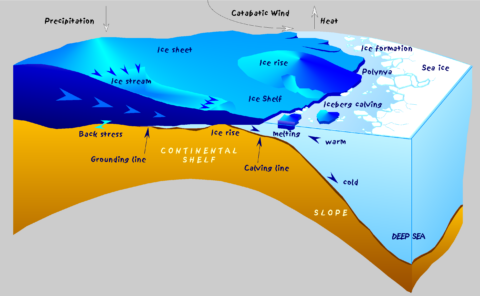
What new technologies are being used to increase our understanding?
New technologies, in particular those independent of icebreakers, have increased the spatial and temporal coverage for data acquisition.
Moorings, and the increasingly sophisticated sensors deployed on them, have allowed for automated winter measurements, especially under the sea ice. These include sediment traps, nutrient sensors, water column profilers, and passive acoustic sensors for listening to marine mammal songs.
New remote sensors can measure ice thickness, while ARGO floats show the pattern of circulation and provide high resolution data on water-column properties. Also, CTD (conductivity, temperature, depth) devices have been deployed with marine mammals, and gliders are being used to detect zooplankton.
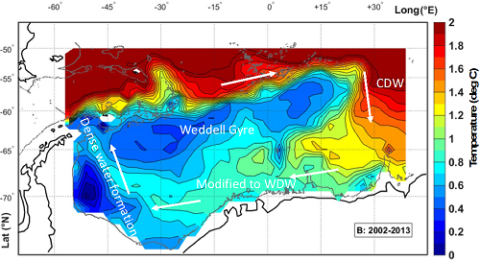
Remote sensing has provided ocean color data that has revealed a previously unknown abundance of patchy plankton blooms, particularly near the continent and at the ice margins, even in the almost inaccessible southwestern parts of the Weddell Gyre.
Meanwhile, genomics for biological diversity have made amazing developments, and trace metal clean sampling has provided the very first data for essential micronutrients of plankton like iron.
What are some of the more recent advances in knowledge?
The Weddell Gyre has been found to have unique geochemical features at mid-depth that seem to be related to the unusually strong remineralization of organics.
Other research has revealed how water masses are transformed within the gyre before they are exported, and the variability of this process. For example, the Weddell Sea Bottom Water, feeding the Antarctic Bottom Water, is composed of 71% modified Weddell Deep Water and 29% dense Shelf Waters, the latter driving overall variability, which recent studies indicate is the import of deep water from the eastern edge of the Weddell Gyre.
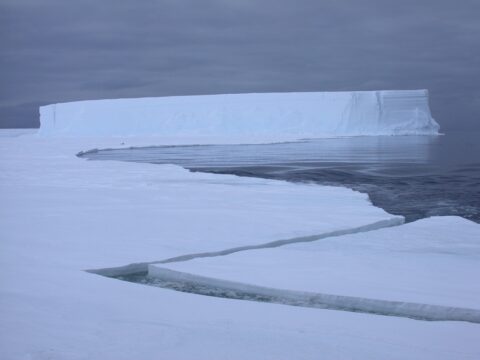
The Filchner-Ronne Ice Shelf borders the Weddell Sea to the south and is the second-largest ice shelf in Antarctica.
It has been found recently to be affected by penetrations of Weddell Deep Water during austral summer months. This relatively warm water mass leads to enhanced under-shelf ice melting.
This ice shelf plays a key role in the formation of Weddell Sea Deep and Bottom Water, which are precursors of world ocean’s Antarctic Bottom Water.
Meanwhile, research suggests that there has been an intensification of the gyre circulation reflected in enhanced upwelling at the center, presumably by a poleward shift of the circumpolar winds.
Finally, two new unexplored penguin colonies have been detected around the coastal regions in the southern Weddell Sea, at the southwest of the Weddell Gyre.
Why is an interdisciplinary and international approach important in these studies?
Collaboration is critical. Understanding the Weddell Gyre and predicting future change in this system requires understanding of the water column, sea ice, topography, ice shelves, birds and marine mammals, the troposphere, and myriad other elements that interact within the gyre. This requires inputs from physical, chemical and biological oceanographers; engineers and technicians; modelers; geological and geophysical scientists. Only an interdisciplinary approach will help to answer complex questions relating to the Antarctic region.
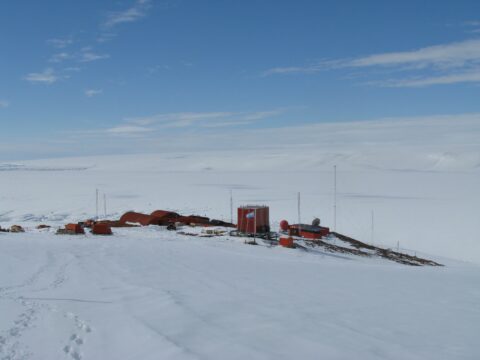
At the same time, the research community involved in this effort is relatively small.
Taking into account the challenges of accessibility and cost described earlier, no single country has the capacity to research all aspects of the gyre.
But through collaboration, many ARGO floats can be deployed, moorings can be picked up, and data shared across the international research community.
Antarctica has a long history of international collaboration coordinated by the Scientific Committee on Antarctic Research.
What are some of the unresolved questions where additional research, data or modeling is needed?
Our review was co-authored by a large group of researchers and each member from each sub-discipline has their own unresolved questions. However, we identified some overarching issues and interdisciplinary priorities including a need for increased knowledge during winter conditions; understanding the connectivity between the Weddell Gyre and lower latitudes; and the rate and processes involved in the recent intensification of the gyre.
By addressing these lines of research, we anticipate providing answers to climate-related issues involving the Weddell Gyre. However, it will not be possible to answer all questions, since we do not even know the “known unknowns”.
—Maria Vernet ([email protected]; ![]() orcid.org/0000-0001-7534-5343), Scripps Institution of Oceanography, USA; Mario Hoppema (
orcid.org/0000-0001-7534-5343), Scripps Institution of Oceanography, USA; Mario Hoppema (![]() orcid.org/0000-0002-2326-619X) and Walter Geibert (
orcid.org/0000-0002-2326-619X) and Walter Geibert (![]() orcid.org/0000-0001-8646-2334), Alfred Wegener Institute Helmholtz Centre for Polar and Marine Research, Germany
orcid.org/0000-0001-8646-2334), Alfred Wegener Institute Helmholtz Centre for Polar and Marine Research, Germany
Citation:
Vernet, M.,Hoppema, M., and Geibert, W. (2019), Science in a frozen ocean, Eos, 100, https://doi.org/10.1029/2019EO129157. Published on 26 July 2019.
Text © 2019. The authors. CC BY-NC-ND 3.0
Except where otherwise noted, images are subject to copyright. Any reuse without express permission from the copyright owner is prohibited.

